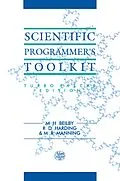The Scientific Programmer's Toolkit: Turbo Pascal Edition presents a complete software environment for anyone writing programs in mathematical, engineering, or science areas. This toolkit package is designed for use with Turbo Pascal, the de facto standard Pascal system for PC and compatible machines. The book and its software provides an integrated software library of programming tools. The programs and routines fall into three categories: graphical, mathematical, and utilities. Routines are further subdivided into three levels that reflect the experience of the user. For graphics and text handling routines there is also a Level 0, which provides an interface to the machine operating system. By using hierarchically structured routines, the clearly written text, and a wide range of example programs, software users can construct a user-friendly interface with minimal effort. The levels structure makes it easy for newcomers to use the Toolkit, and with growing experience, users can achieve more elaborate effects. The Scientific Programmer's Toolkit will be useful to consultants, researchers, and students in any quantitative profession or science, in private or public sector research establishments, or in secondary and higher education.
Autorentext
Dr M H Beilby is a Lecturer and Director of the Centre for Computer-based Learning at the University of Birmingham. He introduced computational mathematics courses to Birmingham and is a founder member of the CIText Group. Dr R D Harding is the Assistant Director of Research in the Department of Applied Mathematics and Theoretical Physics (DAMTP) at the University of Cambridge. He has been running the CATAM project since 1971 and is a founder member and chairman of the CIText group. Dr Harding is also the Series Editor of the Adam Hilger Computer Illustrated Text Series. Dr M R Manning has been a Computer Officer at DAMTP since 1984. He is an assessor for the CATAM course and is also a founder member of the CIText Group.
Inhalt
Acknowledgments -- Guide to installing the software -- 1 Hard disc systems -- 2 Double-drive floppy disc systems -- 3 Single-drive floppy disc systems -- 4 Network systems -- 5 Reformatting compressed source -- Guide to running the software -- 1 Executable programs -- 2 Programs provided in source code -- Introduction -- 1 Overview of the Toolkit -- 2 How to use this manual -- 3 How to use the examples -- 4 On-line documentation -- 5 Further reading -- 6 Problems and suggestions -- 1 Introducing the Toolkit -- 1.1 Preliminary -- 1.2 Toolkit levels -- 1.3 Using the Toolkit from Pascal -- 1.4 How to use a unit -- 1.5 Fundamental Toolkit definitions -- 2 Level 3 programs -- 2.1 The Level 3 programs -- 2.2 Running the Level 3 programs -- 2.3 The program TK -- 2.4 The program LAPLACE -- 2.5 The program ODE1 -- 2.6 The program FSCOEFF -- 2.7 Preparing data for Level 3 programs -- 3 Graphics routines -- 3.1 Introduction to Level 2 -- 3.2 How errors are dealt with -- 3.3 Graphics demonstrations -- 3.4 Introduction to Level 2 graphics routines -- 3.5 The Draw_curve family -- 3.6 The Sample_function family -- 3.7 The Draw_data family -- 3.8 The Draw_histogram family -- 3.9 The Draw_surface family -- 3.10 Routine Draw_ revolution -- 4 Mathematical routines I -- 4.1 Solution of equations -- 4.2 Maxima and minima -- 4.3 Fitting curves to data -- 4.4 Integration -- 4.5 Ordinary differential equations -- 4.6 Fourier transforms -- 5 Mathematical routines II -- 5.1 Solution of linear equations -- 5.2 Matrix eigenvalues -- 5.3 Matrix decomposition -- 5.4 Least squares data fitting -- 6 Windows and menus -- 6.1 Windows -- 6.2 Control -- 6.3 Help -- 6.4 Options -- 6.5 Menus -- 6.6 Display -- 6.7 Edit -- 7 Graphics routines -- 7.1 Introduction to Level 1 -- 7.2 How errors are dealt with -- 7.3 Introduction to Level 1 graphics routines -- 7.4 Graph port routines -- 7.5 Graphics parameters -- 7.6 Graphics parameter procedures -- 7.7 Scaling and axes routines -- 7.8 Conversion to screen coordinates -- 7.9 Moving and drawing in user-coordinates -- 7.10 Labels, symbols and cross-wires -- 7.11 Polygons -- 7.12 Related primitives -- 7.13 Examples -- 8 Screen and text utilities -- 8.1 Windows on the screen -- 8.2 Manipulating text objects -- 9 Formatting values and evaluating expressions -- 9.1 Unit Cit_form -- 9.2 Unit Cit_eval -- Appendices -- 1 Unit Cit_core -- 2 Unit Cit_prim -- 3 Table of error messages -- Index.
